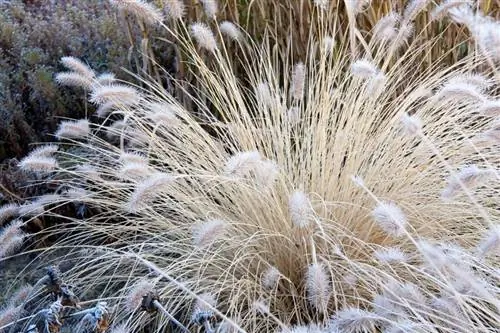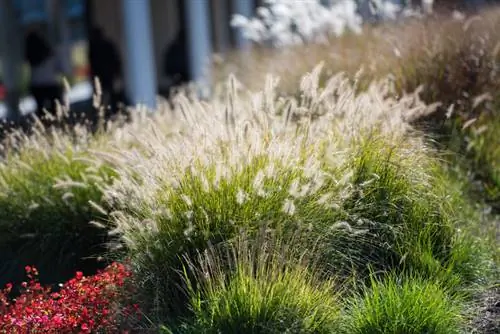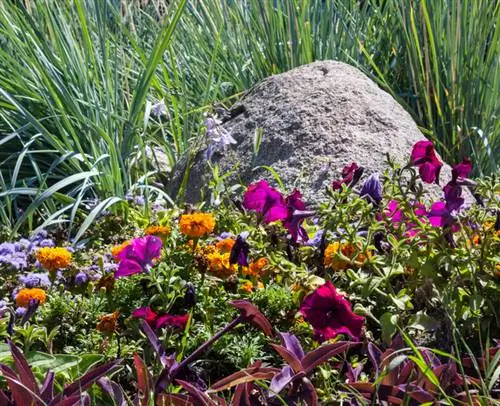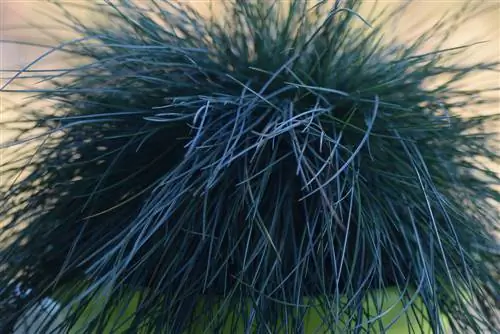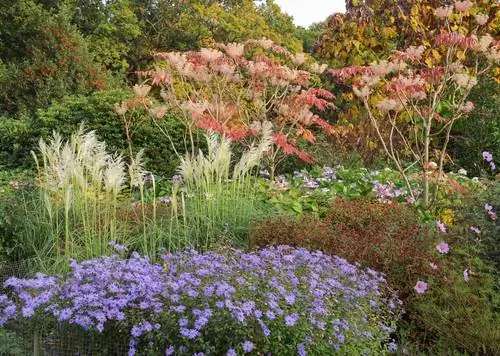- Author admin [email protected].
- Public 2023-12-25 17:45.
- Last modified 2025-01-23 11:22.
In order for ornamental grasses to meet expectations as a picturesque accessory or ornamental solitaire, a professionally tailored package of measures is required. Although species-typical subtleties must be taken into account, essential premises apply to the entire group of these ornamental plants. Get a detailed overview of the general requirements for cultivating ornamental grass here. The following answers to frequently asked questions get to the heart of the matter.
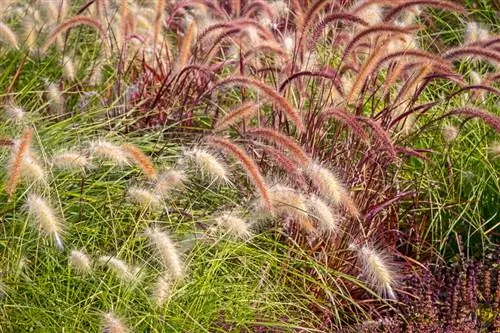
How do you successfully cultivate ornamental grasses?
The successful cultivation of ornamental grasses requires professional care, a well-chosen location and correct water and nutrient management. Spring planting and the regular addition of organic fertilizer promote the he alth and appearance of ornamental grasses.
Planting ornamental grasses correctly
The window for the ideal planting time for ornamental grass opens in April. As part of the preparation work, place the still potted root ball in water until no more air bubbles appear. Meanwhile, loosen the soil thoroughly at the appropriate location to remove roots, stones and weeds. Dig a planting pit that is slightly larger than the root ball. Place the soil in a wheelbarrow to mix with compost and horn shavings. Now pot up the soaked root ball and position it in the middle of the pit so that the previous planting depth is maintained. Fill the cavities with the substrate, press everything down and water. A mulch layer of leaves, grass clippings or bark mulch provides natural support for rapid rooting.read more
Care tips
Regardless of the type of ornamental grass chosen, the following priorities should be set in professional care across all species:
- Never let the root ball dry out or drown it in waterlogging
- Fertilize the bed organically in March/April and at the beginning of the flowering period
- In autumn, tie the clump loosely together and cover the root disc with leaves
- Cut back to 10 cm above the ground before fresh shoots appear in early spring
In pot culture, water more regularly as the substrate dries out quickly. Fertilize from March to August every 3-4 weeks with a liquid fertilizer for green plants, which is diluted by half with water. It is an advantage if ornamental grass in a pot can spend the winter in a bright, frost-free area. Alternatively, cover the container with bubble wrap or colorful jute ribbons and place a cold-insulating wooden block underneath. Please remember that evergreen ornamental grass species and varieties continue to evaporate moisture in both the bed and the pot. If the root ball is threatened by drought stress, water on mild days.read more
Which location is suitable?
Ornamental grasses are always happy with a partially shaded location. Selected types of ornamental grass, such as pampas grass or silver ear grass, thrive in full sun. Mother Nature even has beautiful specimens available for shady places, such as the mushroom head sedge or the moor pipe grass. With regard to the nature of the soil, it can be stated as a general rule that fresh, well-drained soil is desirable. With very few exceptions, ornamental grasses know how to cope better with short-term drought than with waterlogging.
The correct planting distance
In view of the different growth heights and widths of ornamental grasses, no general statement can be made about the best planting distance. As a rule of thumb, use the expected growth width as a basis for a solitary ornamental grass in the bed. As a group, reduce this value by 5-10 cm. The local requirements of neighborhood law apply to the correct distance from neighbors. Contact the responsible public order office so that there is no trouble with the neighbor later.
What is the best time to plant?
In order to give an ornamental grass a proper window of opportunity for rooting, we recommend spring planting. By the first frost, the ornamental grasses have established themselves to such an extent that they can survive the cold season in good he alth. If you choose the planting time in autumn, which is typical for perennials, a thick layer of leaves and needles protects the young root ball from frost damage.read more
When is flowering time?
The central flowering period extends from late summer to well into autumn. This is particularly true for imported ornamental grass species, such as pennisetum, miscanthus or pampas grass. Our native ornamental grasses, on the other hand, stand out in spring with delicate, subtly colored flowers. The heart quaking grass, which blooms from May to July, is a prime example. The ornamental grass is topped by the native mountain sedge, which sets decorative accents from March onwards.
Cut ornamental grasses correctly
Every type of ornamental grass needs its leaves as a protective shield against winter cold and wetness. Therefore, do not cut the plant back at the end of the flowering period or before the first frost. How to do it right:
- In late autumn, tie the eyrie together with ropes to form a loose forelock
- Remove the withered stalks in early spring before the new shoots appear
- Check the nest for overwintering animals in advance in order to reschedule the date if necessary
- Grip the grass with one hand and cut it off close to the ground with the scissors in the other hand
Evergreen ornamental grass can be combed through with a rake or plucked out withered stalks. Do not attempt this work until you have put on sturdy gloves. The edges of the grass are sometimes razor sharp and can cause deep cuts.read more
Watering ornamental grasses
Adjust the water balance to the selected ornamental grass variety. Drought-loving varieties are content with natural rainfall. Where the focus is on a fresh to moist location from the start, always water the perennial when the soil surface is dry. This is less likely to happen in beds than in pots. While the majority of ornamental grasses tolerate short-term drought, waterlogging causes irreparable rot in the root ball.
Fertilize ornamental grasses properly
Fertilize your ornamental grass at the start of the season and again when the flowering period begins. Organic fertilizers such as compost, horn shavings, guano granules or bark humus are well suited for supplying nutrients. In pot culture, administer a liquid fertilizer for green plants every 2-3 weeks from March to August (€6.00 on Amazon).read more
Wintering
The ornamental grass provides its most important winter protection because the stalks protect the root ball from cold and moisture. Therefore, do not cut the perennial back in the fall. Rather, tie the blades of grass together into one or more loose tufts. Colorful jute ribbons create a very decorative appearance. Then cover the root slice thickly with autumn leaves or brushwood. Ornamental grass in a pot ideally moves to bright, frost-free winter quarters. Where this plan fails due to a lack of space, place the pot on wood and wrap it with fleece, jute or foil.
Propagate ornamental grasses
To increase the existing community of your favorite ornamental grasses, divide the rootstock. How to do it right:
- After pruning in spring, lift the root ball out of the ground
- Cut the ornamental grass with a knife, spade or saw
- An optimal section has at least 3-4 leaves or buds
While maintaining the previous planting depth, place the segments in the prepared soil at the new location. Add compost to the excavation there to promote rooting. Adequate water supply is the gardener's top priority in the following days and weeks.
How do I transplant correctly?
The robust constitution of ornamental grass allows it to be moved easily. This is particularly true during the first 5 years of service. For the action, choose a day in spring when the ground has completely thawed. The work will be easier if the necessary pruning has been carried out. Dig up the root ball with as much soil as possible. At the new location, the planting hole should already be prepared and the excavation should be enriched with compost. Maintain the previous planting depth here, tamp down the soil and water.
Ornamental grasses in pots
Some of the most beautiful ornamental grass varieties in pots create eye-catching accents on the balcony, terrace or windowsill. Use a high-quality, structurally stable potting soil with a low peat content. The addition of sand, lava granules and expanded clay ensures good permeability. In addition, drainage made of pottery shards or gravel prevents harmful waterlogging. Constant humidity with intermediate drying phases regulates the water balance. Adequate nutrient supply is ensured by monthly doses of a diluted liquid fertilizer for green plants. If there is no frost-free winter quarters available for the cold season, place the pot on wood in front of the south wall of the house. Additionally, cover the substrate with leaves and wrap the container with foil or jute ribbons.
Is ornamental grass poisonous?
You won't find ornamental grasses in the long lists of poisonous ornamental plants. Given the exuberant diversity of species and varieties, it cannot be ruled out with certainty that there may be one or two slightly poisonous ornamental grasses among them. If in doubt, ask carefully when purchasing to be on the safe side.
Beautiful varieties
For your inspiration, we have put together the following selection of magnificent ornamental grass varieties, carefully selected from hundreds of species and thousands of hybrids.
- Giraffe: Beautiful, ornamental miscanthus thanks to horizontally striped stalks in delicate yellow; 180-250cm
- Pumila: Majestic pampas grass with opulent, silver-white flower flares for sunny locations; 90-250cm
- Karl Foerster: Beautiful riding grass, tightly upright, silvery-pink flowers and beautiful winter look; 100-150cm
- Hänse Herms: Impressive switchgrass with spectacular autumn color in bright red; 70-120cm
- Fireworks: Stunning Pennisetum with purple stalks and cream flowers; 60-100cm
- Transparent: Delicate, lushly branched pipe grass with transparent elegance for partially shaded locations; 60-180cm
- Bronze Veil: Opulent forest Schmiele with golden-yellow flowers in furious fountains until well into autumn; 60-120cm
- Elijah Blue: Blue fescue with steel blue stalks and yellow-brown awns for sunny, hot locations; 15-25cm
- Diamond grass: The ideal ornamental grass for the pot to decorate the autumnal balcony with silvery-pink flowers; 70-80cm
- The Beatles: Shade-tolerant mushroom head sedge with overhanging stalks and early flowering from April; 20-30cm


